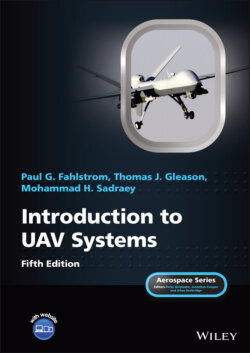Читать книгу Introduction to UAV Systems - Mohammad H. Sadraey - Страница 63
2.3.6 Large UAVs
ОглавлениеOur informal size groupings are not finely divided, and we will discuss all UAVs that are larger than a typical light manned aircraft in the group called “large.” This includes, in particular, a group of UAVs that can fly long distances from their bases and loiter for extended periods to perform surveillance functions. They also are large enough to carry weapons in significant quantities. The lower range of such systems includes the US General Atomics Predator A, which has a significant range and endurance, but can carry only two missiles of the weight presently being used.
Figure 2.5 Medium UAVs
The limitation to two missiles is serious as it means that after firing the two missiles that are onboard, the UAV either has lost the ability to deliver weapons or must be flown back to its base to be rearmed. For this reason, a second generation of UAVs designed for missions similar to that of the Predator, including a Predator B model (i.e., Reaper), is now appearing that is larger and able to carry many more weapons on a single sortie.
The Cassidian Harfang is an example of a system much like the Predator A and the Talarion, also by Cassidian, is an example of the emerging successors to the Predator A.
At the high end of this size group, an example is an even larger UAV designed for very long range and endurance and capable of flying anywhere in the world on its own, the US Northrop Grumman Global Hawk (see Figure 1.4).
There are a number of specialized military and intelligence systems for which information available to the public is very limited. An example of this is the US Lockheed Martin RQ‐170 Sentinel. The RQ‐170 Sentinel is reported to be a stealthy AV manufactured by Lockheed Martin, but limited performance data are available. It is a flying wing configuration much like the Northrop B‐2 Spirit bomber and is in the medium‐to‐large size class, with a wingspan of around 20 m (65 ft) and a length of 4.5 m. This UAV is equipped with a single turbofan engine with 41.26 kN of thrust. In 2011, Iran stated that its Army’s electronic warfare unit had downed an RQ‐170 that violated Iranian airspace along its eastern border through overriding its controls, and had captured the lightly damaged UAV.
The MQ‐1 Predator A is larger than a light single‐engine private aircraft and provides medium altitude, real‐time surveillance using high‐resolution video, infrared imaging, and synthetic aperture radar. It has a wingspan of 17 m (55 ft) and a length of 8 m (26 ft). It adds a significantly higher ceiling (7,620 m or 24,521 ft) and longer endurance (40 h) to the capabilities of the smaller UAVs. GPS and inertial systems provide navigation, and remote control can be via satellite. Cruise speed is 220 km/h (119 knots) and the air vehicle can remain on station for 24 h, 925 km (575 mi) from the operating base. It can carry an internal payload of 200 kg (441 lb) plus an external payload (hung under the wings) of 136 kg (300 lb).
The Harfang UAV is produced by Cassidian, which is a subsidiary of the French company EADS. It is about the same size as the Predator and is designed for similar missions. The configuration is different, using a twin‐boom tail structure. There are a variety of possible payloads. Its stated performance is similar to that of the Predator, but it has a shorter endurance of 24 h. It takes off and lands conventionally on wheels on a runway. Remote control can be via satellite.
Talarion is under development by Cassidian as a second‐generation successor to the Predator/Harfang class of UAVs. It uses two turbojet engines and can carry up to 800 kg (1,764 lb) of internal payload and 1,000 kg (2,205 lb) of external payload with a ceiling of over 15,000 m (49,215 ft) and speeds around 550 km/h (297 knots).
The RQ‐4 Global Hawk (see Figure 1.4) is manufactured by Northrop Grumman Aerospace Systems. It flies at high altitude and utilizes radar, electro‐optical, and infrared sensors for surveillance applications. It uses a turbofan engine and appears to have a shape that reduces its radar signature, but is not a “stealth” aircraft. It is 14.5 m (47 ft) long with a 40 m (129 ft) wingspan and has a maximum weight at takeoff of 1,460 kg (3,219 lb). It can loiter at 575 km/h (310 knots) and has an endurance of 32 h. It has a full set of potential payloads and it appears that it is routinely controlled via satellite links. More information about the Global Hawk is presented in Section 5 of Chapter 1.
Figure 2.6 Large UAVs
Some of these large UAVs are illustrated in Figure 2.6.
